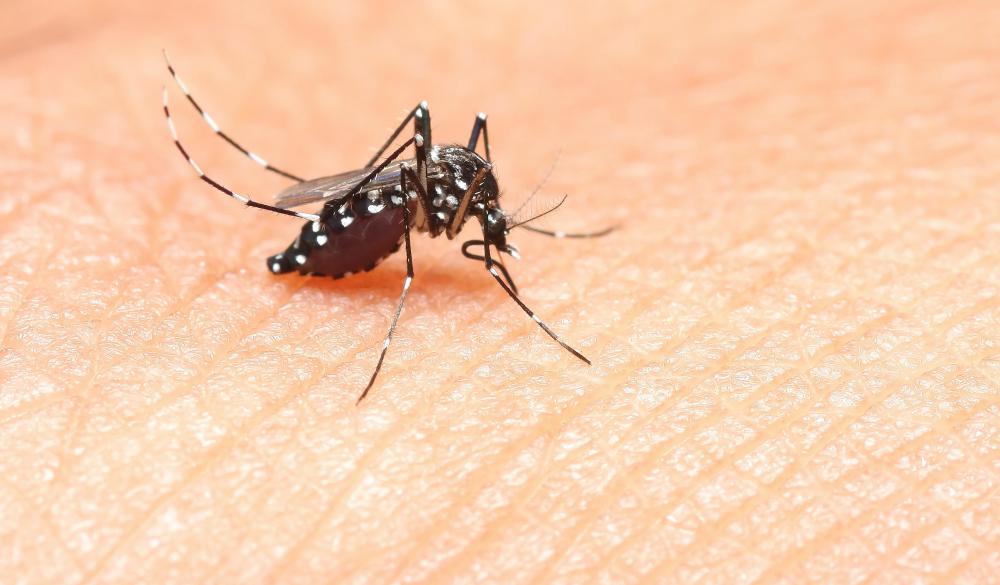At AllThingsNature, we're committed to delivering accurate, trustworthy information. Our expert-authored content is rigorously fact-checked and sourced from credible authorities. Discover how we uphold the highest standards in providing you with reliable knowledge.
What is a Mosquitofish?
Mosquitofish are small freshwater fish most commonly used throughout the United States to control mosquito populations in place of potentially harmful insecticides. The fish readily feed on the aquatic larval and pupal stages of mosquitoes, which is where their name comes from. It is estimated that large female mosquitofish can eat from 100 to 200 mosquito larvae a day, making the species an obvious choice for mosquito control.
Physically, the fish are short and rather thin, and are usually a dull gray color. They are related to the common guppy and resemble the fish physically in many ways. Female fish reach a maximum of 2.8 inches (7 cm) while males reach 1.6 inches (4 cm). Females and males can be differentiated not only by their size but by their rear fins. The males’ fins are pointed, while the females’ fins are round.

While the names "mosquitofish" generally refers to the species Gambusia affinis, there are also many subspecies of the fish. They are thought to be one of the most widespread freshwater fish in the world because of their remarkable ability to survive in poor and extreme water conditions. The lifespan of a normal mosquitofish is short, and they normally live from one to three years. The fish have very successful breeding habits, giving the mosquitofish an astounding ability to multiply their species rapidly. Female fish often birth three or four broods a season, with broods reaching up to 100 fish at a time.
The use of these fish to control mosquito populations is referred to as biological control, and it is practiced around the world. Not only are these fish well known for their famously insect-centered diet, but they are also popular for their tendency to eat algae. Their well-known eating habits mean many public ponds and lakes are stocked with these fish; the species is also popular with backyard pond and water garden owners.
Although the fish thrive in natural environments that host the necessary insects to feed their appetite, some aquarium enthusiasts have been known to keep the species, as well. For those who wish to keep the fish in smaller, artificial habitats, the fish will need to be placed in at least a 20-gallon (76 liter) tank. Water temperatures will need to range from 65° to 75°F (18.3° to 23.9°C) and the fish will need plenty of plants in which to hide. For those keeping the fish indoors, live bugs, algae, and food flakes can supplement their diet in the absence of mosquitoes.
Frequently Asked Questions
What exactly is a mosquitofish?
A mosquitofish, belonging to the species Gambusia affinis, is a small freshwater fish native to the United States. It's renowned for its voracious appetite for mosquito larvae, which has made it a popular biological control agent in mosquito management programs worldwide. Despite its small size, typically 1.5 to 3 inches, its impact on controlling mosquito populations is significant.
Where can mosquitofish be found?
Mosquitofish are originally from the southeastern United States but have been introduced globally to control mosquitoes. They thrive in a variety of freshwater habitats, including streams, ponds, and marshes. Their adaptability allows them to survive in both clean and polluted waters, making them a resilient species in diverse environments.
How do mosquitofish help control mosquito populations?
Mosquitofish contribute to mosquito control by consuming large quantities of mosquito larvae and pupae. A single mosquitofish can eat dozens to hundreds of mosquito larvae per day, according to the University of California's Integrated Pest Management Program. This appetite makes them an effective natural predator in reducing the number of mosquitoes, which can transmit diseases like West Nile virus and Zika.
Are mosquitofish considered invasive?
While mosquitofish are beneficial for mosquito control, they are considered invasive in many regions outside their native range. Their introduction into non-native ecosystems can lead to the decline of local fish and amphibian populations, as they outcompete native species for food and habitat. Their aggressive nature and high reproductive rate exacerbate these issues.
How do mosquitofish reproduce, and how fast do they grow?
Mosquitofish are livebearers, meaning they give birth to live, free-swimming young rather than laying eggs. Females can produce broods of 20 to 100 fry every few weeks during the breeding season. The fry grow rapidly and can reach sexual maturity in as little as 4 to 6 weeks, allowing for quick population expansion.
Can mosquitofish survive in cold temperatures?
Mosquitofish are quite hardy and can survive in a range of temperatures, but they prefer warmer waters. They can tolerate temperatures as low as about 50 degrees Fahrenheit but are most active and effective at mosquito control in warmer waters. In colder climates, they may seek out thermal refuges or experience reduced metabolic rates.
AS FEATURED ON:
AS FEATURED ON:











Discuss this Article
Post your comments